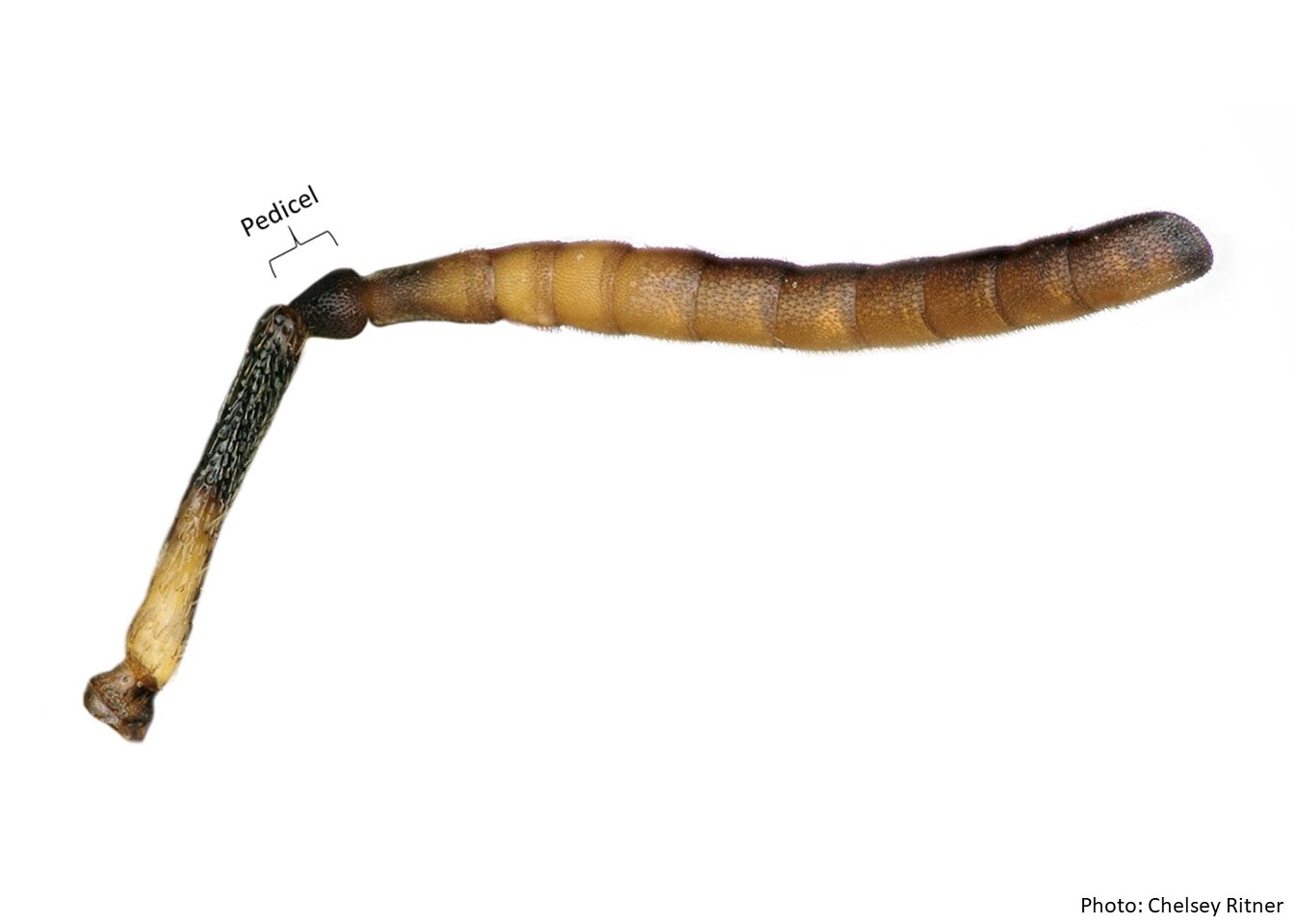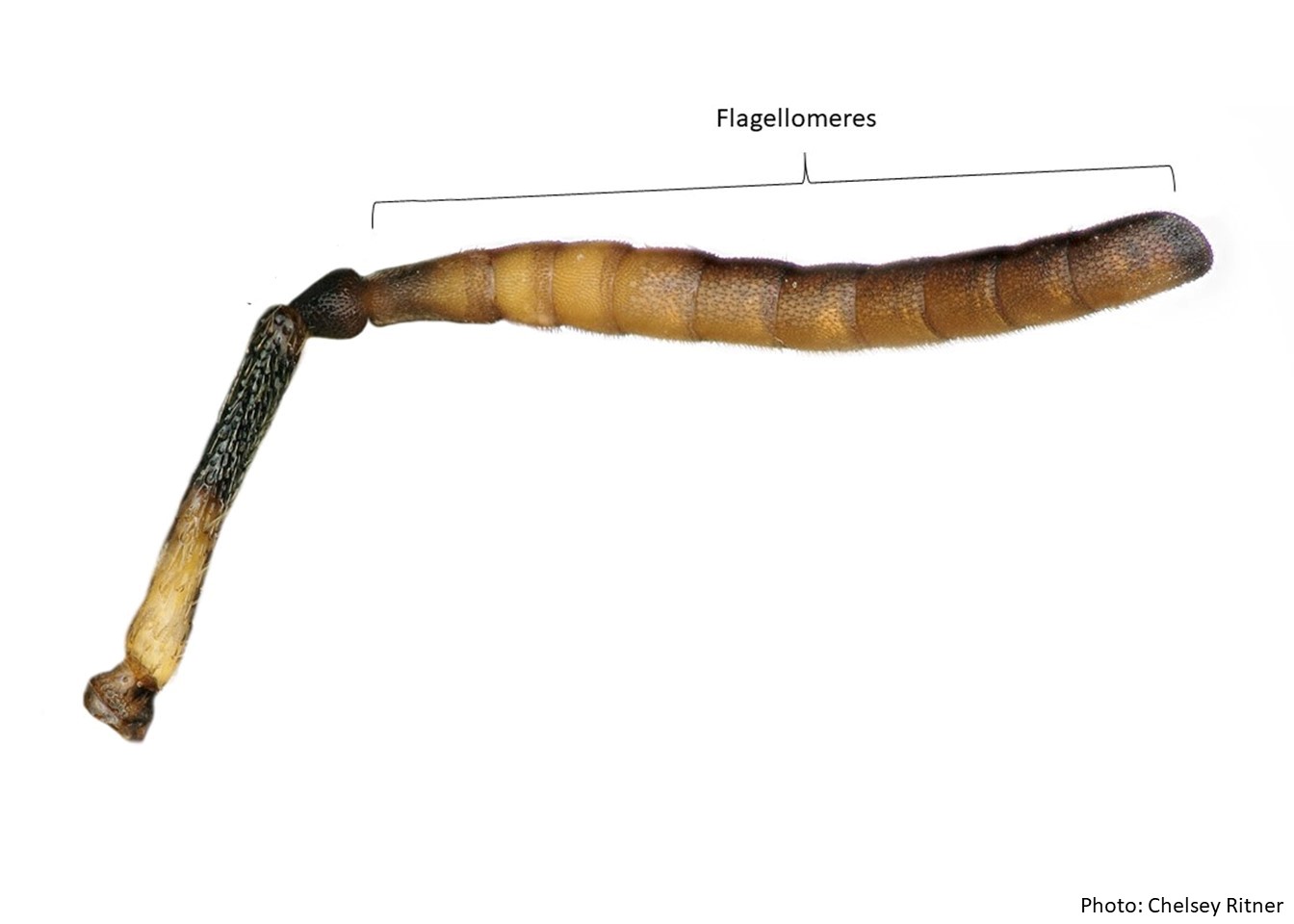Family: Megachilidae
Subfamily: Megachilinae
Tribe: Osmiini
Genus: Osmia Panzer, 1806
Subgenus: Hemiosmia Tkalců, 1975
Common name: none
Osmia (Hemiosmia) are non-metallic bees with pale pubescencepubescence:
short, fine hair
on their head, thorax, and abdomen, and often have apicalapical:
near or at the apex or end of any structure
fasciae on their tergaterga:
the segments on the top side of the abdomen, often abbreviated when referring to a specific segment to T1, T2, T3, T4, T5, T6, or T7 . They range in body length from 7–13.5 mm (Michener 2007Michener 2007:
. They range in body length from 7–13.5 mm (Michener 2007Michener 2007:
Michener, C.D. 2007. The Bees of the World (2nd ed.). Johns Hopkins University Press, Baltimore and London, 953 pp.).
(modified from Michener 2007Michener 2007:
Michener, C.D. 2007. The Bees of the World (2nd ed.). Johns Hopkins University Press, Baltimore and London, 953 pp.)
 .
. .
. crenulatecrenulate:
crenulatecrenulate: with strong posterolateral tooth.
with strong posterolateral tooth.Female Osmia (Hemiosmia) may be confused with O. (Cephalosmia) because both subgenera can have an angle or tooth on the inner ventralventral:
of, on, or relating to the underside of an animal, or segment of an animal
margin, but can be differentiated by the smaller and more closely punctatepunctate:
studded with tiny holes
clypeusclypeus:
a section of the face below the antennae, demarcated by the epistomal sutures (Michener 2007Michener 2007:
Michener, C.D. 2007. The Bees of the World (2nd ed.). Johns Hopkins University Press, Baltimore and London, 953 pp.).
Osmia (Hemiosmia) are specialists on Fabaceae (Haeseler 2008Haeseler 2008:
Haeseler, V. 2008. Zur Biologie der mediterranen Mauerbienen Osmia balearica Schmiedeknecht 1885 und Osmia uncicornis Peacute;rez 1895 (Hymenoptera: Apidae). Abhandlungen des Naturwissenschaftlichen Vereins zu Bremen 46: 289ndash;300.; Rozen et al. 2010Rozen et al. 2010:
Rozen Jr., J.G., H. Ouml;zbek, J.S. Ascher, C. Sedivy, C. Praz, A. Monfared, and A. Muller. 2010. Nests, petal usage, floral preferences, and immatures of Osmia (Ozbekosmia) avosetta (Megachilidae: Megachilinae: Osmiini), including biological comparisons with other osmiine bees. American Museum Novitates 3680: 1ndash;22.; Müller 2018). Osmia iberica has also been observed collecting from Antirrhineae (Müller 2018).
Species within the subgenera O. (Hemiosmia) often use masticated leaves to build cells in nests in excavated burrows in loose soil (Haeseler 2008Haeseler 2008:
Haeseler, V. 2008. Zur Biologie der mediterranen Mauerbienen Osmia balearica Schmiedeknecht 1885 und Osmia uncicornis Peacute;rez 1895 (Hymenoptera: Apidae). Abhandlungen des Naturwissenschaftlichen Vereins zu Bremen 46: 289ndash;300.; Rozen et al. 2010Rozen et al. 2010:
Rozen Jr., J.G., H. Ouml;zbek, J.S. Ascher, C. Sedivy, C. Praz, A. Monfared, and A. Muller. 2010. Nests, petal usage, floral preferences, and immatures of Osmia (Ozbekosmia) avosetta (Megachilidae: Megachilinae: Osmiini), including biological comparisons with other osmiine bees. American Museum Novitates 3680: 1ndash;22.). Osmia balearica nests in burrows in loose, sandy soil near dead plants. The dead plant roots are used to attach the cells in the ground. Similar to O. balearica, O. uncicornis and O. difficilis also nest in excavated burrows in loose, sandy or gravely soil. In O. difficilis, plant roots were not attached to the cell as seen in O. balearica and O. uncicornis (Haeseler 2008Haeseler 2008:
Haeseler, V. 2008. Zur Biologie der mediterranen Mauerbienen Osmia balearica Schmiedeknecht 1885 und Osmia uncicornis Peacute;rez 1895 (Hymenoptera: Apidae). Abhandlungen des Naturwissenschaftlichen Vereins zu Bremen 46: 289ndash;300.; Müller 2018). Osmia argyropyga nest in abandoned nest cells of Megachile pyrenaica (Müller 2018).
Osmia (Hemiosmia) contains seven species (Müller 2018). None are known to occur in the U.S. or Canada.
There are no known invasives.
Osmia (Hemiosmia) can be found from the Mediterranean to East and Central Asia (Michener 2007Michener 2007:
Michener, C.D. 2007. The Bees of the World (2nd ed.). Johns Hopkins University Press, Baltimore and London, 953 pp.).

Distribution map generated by Discover Life -- click on map for details, credits, and terms of use.
Friese, H. 1923. Die europäischen Bienen (Apidae). Das Leben und Wirken unserer Blumenwespen. Berlin: Walter de Gruyter. 456 pp.
Haeseler, V. 2008. Zur Biologie der mediterranen Mauerbienen Osmia balearica Schmiedeknecht 1885 und Osmia uncicornis Pérez 1895 (Hymenoptera: Apidae). Abhandlungen des Naturwissenschaftlichen Vereins zu Bremen 46: 289-300.
Michener, C.D. 2007. The Bees of the World. 2nd ed. Johns Hopkins University Press, Baltimore and London, 953 pp.
Müller, A. 2018. Palaearctic Osmiine Bees, ETH Zürich, http://blogs.ethz.ch/osmiini
Rozen Jr., J.G., H. Özbek, J.S. Ascher, C. Sedivy, C. Praz, A. Monfared, and A. Muller. 2010. Nests, petal usage, floral preferences, and immatures of Osmia (Ozbekosmia) avosetta (Megachilidae: Megachilinae: Osmiini), including biological comparisons with other osmiine bees. American Museum Novitates 3680: 1-22.